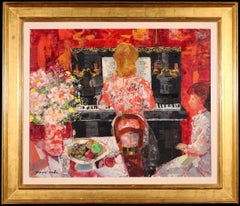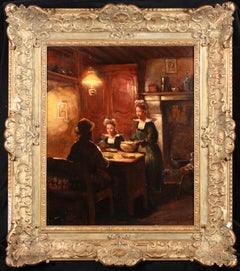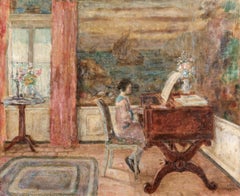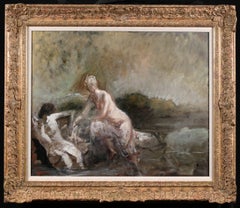Want more images or videos?
Request additional images or videos from the seller
1 of 14
Jean-Louis-Marcel CossonAu Cirque - Post Impressionist Figurative Oil Painting by Marcel Cossonc.1920
c.1920
Price:$9,498.93
$13,701.44List Price
About the Item
- Creator:Jean-Louis-Marcel Cosson (1878 - 1956, French)
- Creation Year:c.1920
- Dimensions:Height: 37 in (93.98 cm)Width: 28 in (71.12 cm)
- Medium:
- Movement & Style:
- Period:
- Condition:Very good condition.
- Gallery Location:Marlow, GB
- Reference Number:Seller: LFA02451stDibs: LU415315951272
About the Seller
5.0
Gold Seller
Premium sellers maintaining a 4.3+ rating and 24-hour response times
Established in 2001
1stDibs seller since 2016
709 sales on 1stDibs
Authenticity Guarantee
In the unlikely event there’s an issue with an item’s authenticity, contact us within 1 year for a full refund. DetailsMoney-Back Guarantee
If your item is not as described, is damaged in transit, or does not arrive, contact us within 7 days for a full refund. Details24-Hour Cancellation
You have a 24-hour grace period in which to reconsider your purchase, with no questions asked.Vetted Professional Sellers
Our world-class sellers must adhere to strict standards for service and quality, maintaining the integrity of our listings.Price-Match Guarantee
If you find that a seller listed the same item for a lower price elsewhere, we’ll match it.Trusted Global Delivery
Our best-in-class carrier network provides specialized shipping options worldwide, including custom delivery.You May Also Like
Interior Scene
Located in Astoria, NY
Andrei Illich Potapenko (Ukranian, 1925-2011), Interior Scene, Oil on Board, 1961, depicting woman in headscarf standing by window, signed and dated lower right, with artist's name a...
Category
1960s Post-Impressionist Interior Paintings
Materials
Oil, Board
Rare French, Paris 1935 Judaica Oil Painting Rabbis Studying S. Fleischman
Located in Surfside, FL
Rare Judaica Art. Jewish genre scene. In the tradition of Moritz Oppenheim, Isidor Kauffman and Maurycy Gottlieb and later of Tully Filmus, Zalman Kleinman and Itshak Holtz the artist captures this Jewish scene with a particular sensitivity. Part of the Ecole De Paris The term "School of Paris" was used in 1925 by André Warnod (fr) to refer to the many foreign-born artists who had migrated to Paris.
School of Paris artists were progressively marginalized. Beginning in 1935 art publications no longer wrote about Marc Chagall, just magazines for Jewish audiences, and by June 1940 when the Vichy government took power, School of Paris artists could no longer exhibit in Paris at all.
The artists working in Paris between World War I and World War II experimented with various styles including Cubism, Orphism, Surrealism and Dada. Foreign and French artists working in Paris included Jean Arp, Joan Miró, Constantin Brâncuși, Raoul Dufy, Tsuguharu Foujita, artists from Belarus like Michel Kikoine, Pinchus Kremegne, and Jacques Lipchitz, the Polish artist Marek Szwarc and others such as Russian-born prince Alexis Arapoff. A significant subset, the Jewish artists, came to be known as the Jewish School of Paris or the School of Montparnasse. The "core members were almost all Jews, and the resentment expressed toward them by French critics in the 1930s was unquestionably fueled by anti-Semitism." One account points to the 1924 Salon des Indépendants, which decided to separate the works of French-born artists from those by immigrants; in response critic Roger Allard (fr) referred to them as the School of Paris. Jewish members of the group included Emmanuel Mané-Katz, Chaim Soutine, Adolphe Féder, Chagall, Moïse Kisling, Maxa Nordau...
Category
Mid-20th Century Post-Impressionist Figurative Paintings
Materials
Oil, Board
$3,200
H 27.5 in W 24 in
Wisdom of King Solomon Rare Biblical Hungarian Judaica Oil Painting
By Anton Peczely
Located in Surfside, FL
Rare Pre World War II (Pre Holocaust) Judaica Art. European Judaic art from this period is exceedingly rare.
Péczely Antal Anton 1891 - 1963
Known for his Jewish genre scenes, Chess scenes and other early 20th Century salon style paintings. In the tradition of Moritz Oppenheim...
Category
Early 20th Century Post-Impressionist Figurative Paintings
Materials
Oil, Board
$3,800
H 28.5 in W 35.5 in
Blessing of the Tzadik (Rebbe) Rare Hungarian Judaica Oil Painting
By Anton Peczely
Located in Surfside, FL
Rare Pre World War II (Pre Holocaust) Judaica Art. European Judaic art from this period is exceedingly rare.
Péczely Antal Anton 1891 - 1963
Known for his Jewish genre scenes, Chess scenes and other early 20th Century salon style paintings. In the tradition of Moritz Oppenheim...
Category
Early 20th Century Post-Impressionist Figurative Paintings
Materials
Oil, Board
$3,800
H 27.5 in W 35 in
Contemporary Large-Scale Cubist Figurative Abstract Lavender Interior Scene
By Michael William Eggleston
Located in Soquel, CA
Contemporary Large-Scale Cubist Figurative Abstract Lavender Interior Scene
Bursting with bright colors and whimsical energy, this contemporary figurative abstract painting by San ...
Category
Early 2000s Fauvist Figurative Paintings
Materials
Cardboard, Oil
$2,280 Sale Price
20% Off
H 40 in W 30 in D 1 in
Red Couch, Black Cat - Contemporary Fauvist Interior Scene in Primary Colors
By Jonathan Taylor
Located in Soquel, CA
Fun and colorful contemporary Fauvist interior scene of a black cat lounging on a red couch in a brightly hued room in primary colors, by Jonathan Taylor (American, b.1966).
Signed "J. Taylor" in bottom right.
Displayed in a giltwood frame.
Image size: 19.5" H X 23.5" W.
Artist Jonathan Taylor was born in 1966 and was raised in Bar Harbor Maine...
Category
2010s Fauvist Interior Paintings
Materials
Canvas, Oil, Cardboard
$1,699
H 19.5 in W 23.5 in D 1.5 in
"Outdoor Summer Scene" Figure w Pet Dog Post-Impressionist Oil Painting Framed
By Jacques Zucker
Located in New York, NY
A charming oil painting depicting an exterior summer scene of an elegant woman crossing her legs, reclining on a chair with her loved pet dog. She exudes a calmness while we can fee...
Category
20th Century Post-Impressionist Figurative Paintings
Materials
Oil, Board
$2,000
H 15 in W 13 in D 1.5 in
Woman and guitar oil on board painting fauvism
By Jordi Curos
Located in Barcelona, Barcelona
Jordi Curós Ventura (1930-2007) - Woman - Oil on board.
Work measurements 46x38 cm.
Frame size 64x56 cm.
Jordi Curós Ventura (Olot, Girona, March 4, 1930) is a Spanish painter.
He ...
Category
1980s Fauvist Figurative Paintings
Materials
Oil, Board
$635 Sale Price
34% Off
H 18.12 in W 14.97 in
20th century Spanish Cafe scene with dancing and drinking figures in a bar
By Alfredo Opisso
Located in Woodbury, CT
This captivating mid-century Spanish painting by Alfredo Opisso immerses the viewer in the lively atmosphere of a café or bar, where figures gather to drink, sing, and dance. Rendere...
Category
1960s Post-Impressionist Figurative Paintings
Materials
Oil, Board
Alfredo Opisso20th century Spanish Cafe scene with dancing and drinking figures in a bar, circa 1965
$3,180
Free Shipping
H 15 in W 18 in
Painting Study of Al Fresco Spanish Tapas Bar Scene at Night by British Artist
By Angela Wakefield
Located in Preston, GB
Painting Study of Al Fresco Spanish Tapas Bar Scene at Night by leading British Landscape Artist, Angela Wakefield.
Art measures 12 x 12 inches
Frame me...
Category
2010s Post-Impressionist Interior Paintings
Materials
Gesso, Fiberboard, Board, Acrylic, Oil, Mixed Media, Varnish, Paint
Angela WakefieldPainting Study of Al Fresco Spanish Tapas Bar Scene at Night by British Artist, 2012
$2,700 Sale Price
20% Off
H 16 in W 16 in D 1.75 in
More From This Seller
View AllLe Piano - Post Impressionist Figurative Interior Painting by Emilio Grau Sala
By Emilio Grau Sala
Located in Marlow, Buckinghamshire
Signed and titled oil on canvas figure in interior circa 1950 by Spanish post impressionist Emilio Grau Sala. The work depicts a red-haired lady in a red dress seated at a piano. A y...
Category
1950s Post-Impressionist Figurative Paintings
Materials
Oil, Canvas
A Breton Interior - Impressionist Interior Oil Painting by Edouard Cortes
By Édouard Leon Cortès
Located in Marlow, Buckinghamshire
Signed figures in interior oil on canvas circa 1910 by sought after French impressionist painter Edouard Leon Cortes. This charming and nostalgic work depicts a family enjoying dinne...
Category
Early 20th Century Impressionist Interior Paintings
Materials
Canvas, Oil
The Piano Recital - Impressionist Figurative Interior Oil by Frederick Frieseke
By Frederick Carl Frieseke
Located in Marlow, Buckinghamshire
Signed and dated oil on canvas figure in interior painting by American impressionist painter Frederick Carl Frieseke. The piece depicts a young girl in a pink dress seated at a piano...
Category
1920s American Impressionist Figurative Paintings
Materials
Oil, Canvas
Les Baigneuses - Impressionist Figurative Landscape Oil by Jean Louis Forain
By Jean Louis Forain
Located in Marlow, Buckinghamshire
Signed impressionist figurative oil on canvas circa 1890 by sought after French impressionist painter Jean Louis Forain. The piece depicts bathers in a dark landscape.
Signature:
Signed lower right
Dimensions:
Framed: 32"x37"
Unframed: 24"x29"
Provenance:
Private French collection
Jean Forain was the son of a painter and decorator and was apprenticed to a visiting card engraver. He studied briefly under Gérôme and Carpeaux at the École des Beaux-Arts in Paris and regularly visited the Louvre, where he copied works by the masters. It is said that for a time he made a precarious living by selling small drawings in the style of Grévin. He went on to collaborate on various publications as a draughtsman and columnist, starting in 1876 on La Cravache and then collaborating on the newspapers Le Journal Amusant, Le Figaro and L'Écho de Paris. This introduced him to the diverse worlds of Paris society - the world of the theatre, of shows, and of literature - where he wryly noted the habits and shortcomings particular to each. This led him to follow a route very characteristic of this period, already seen in the work of Steinlen, Caran d'Ache and Toulouse-Lautrec in the journals La Pléiade, La Vogue...
Category
1890s Impressionist Figurative Paintings
Materials
Canvas, Oil
Interieur - Effet de Lampe - Impressionist Interior Oil by Edouard Cortes
By Édouard Leon Cortès
Located in Marlow, Buckinghamshire
Signed figures in interior oil on canvas circa 1920 by sought after French impressionist painter Edouard Leon Cortes. This charming and nostalgic work depicts a family in a typical Breton kitchen scene. An elderly lady is seated at the table with her back to the artist and a young girl also sits at the table beside a bowl of oranges and a carafe of red wine. Another lady stands at the table under the light of the lamp.
Signature:
Signed lower right
Dimensions:
Framed: 29.5"x34"
Unframed: 21.5"x26"
Provenance:
Salon des Independants - 1922 exhibition
Galleries Maurice Sternberg - Chicago
Original artists label with title and number "9" on the reverse.
Edouard Leon Cortes, the son of the painter Antonio Cortès, was sent to the front during World War I to sketch enemy positions. In civilian life, his base was in Lagny in the former studio of Cavallo-Peduzzi. Although he travelled extensively in France. Notably in Normandy, Brittany, the Champagne region and Savoy painting...
Category
1920s Impressionist Figurative Paintings
Materials
Oil, Canvas
Deux vieillards aux chatons - Impressionist Figurative Oil by J F Raffaelli
By Jean-Francois Raffaelli
Located in Marlow, Buckinghamshire
Signed figures in interior oil on panel by French impressionist painter Jean-Francois Raffaelli. The piece depicts two old men seated in an interior. One is reading his paper as the other naps and there are several kittens on the floor. Painted in the artist's distinctive style.
Signature:
Signed lower left
Dimensions:
Framed: 9.5"x8"
Unframed: 5.5"x4"
Provenance:
Brame & Lorenceau have confirmed the authenticity of this work and it will be included in the digital catalogue raisonne of the painter which is under preparation
A certificate of authenticity fromBrame & Lorenceau accompanies this painting
Private collection - United States
Original artists label verso
Jean-François Raffaëlli's father was a failed Italian businessman and Raffaëlli himself was, among other things, a church chorister, actor and theatre singer. He then studied under Gérôme at the École des Beaux-Arts in Paris. He travelled to Italy, Spain and Algeria and on his return to France settled in Asnières.
In 1876, on a trip to Brittany, he first saw the potential of realist subject matter, if treated seriously. He became involved in meetings of artists at the Café Guerbois, where the Impressionist painters used to gather. As a result, Degas, contrary to the advice of the group, introduced Raffaëlli to the Impressionist exhibitions - according to one uncertain source as early as the very first exhibition, at the home of Nadar, and certainly to those of 1880 and 1881.
In 1904, Raffaëlli founded the Society for Original Colour Engraving. He first exhibited at the Salon de Paris in 1870 and continued to exhibit there until he joined the Salon des Artistes Français in 1881, where he earned a commendation in 1885, was made Chevalier of the Légion d'Honneur in 1889 and in the same year was awarded a gold medal at the Exposition Universelle. In 1906 he was made Officier of the Légion d'Honneur. He was also a member of the Société Nationale des Beaux-Arts. In 1884, a private exhibition of his work cemented his reputation.
He contributed to several newspapers such as The Black Cat (Le Chat Noir) in 1885 and The French Mail (Le Courrier Français) in 1886 and 1887. He published a collection entitled Parisian Characters, which captured his favourite themes of the street, the neighbourhood and local people going about their lives. In 1880 he participated, with Forain, on the illustration of Joris Karl Huysmans' Parisian Sketches (Croquis Parisiens). He also illustrated Huysman's Works. As well as working as an illustrator, he also made etchings and coloured dry-points.
His early attempts at painting were genre scenes, but once he was settled in Asnières he started to paint picturesque views of Parisian suburbs. From 1879 onwards, his subject matter drew on the lives of local people. These popular themes, which he treated with humanity and a social conscience, brought him to the attention of the social realist writers of the time such as Émile Zola. In addition to his realist style, Raffaëlli's dark palette, which ran contrary to the Impressionist aesthethic, helped to explain the opposition of those painters to his participation in their exhibitions. More concerned with drawing than colour, he used black and white for most of his paintings. Towards the end of his life, he lightened his palette, but without adopting any other principles of the Impressionist technique.
After painting several portraits, including Edmond de Goncourt and Georges Clémenceau, he returned to genre painting, particularly scenes of bourgeois life. Later in his career, he painted mainly Breton-inspired sailors and views of Venice. His views of the Paris slums and the fortifications, sites which have almost completely disappeared, went some way towards establishing a genre in themselves and perpetuated the memory of the area: The Slums, Rag-and-Bone Man, Vagabond, Sandpit, In St-Denis, Area of Fortifications. His realistic and witty portrayal of typical Parisian townscapes accounts for his enduring appeal.
Born in Paris, he was of Tuscan descent through his paternal grandparents. He showed an interest in music and theatre before becoming a painter in 1870. One of his landscape paintings was accepted for exhibition at the Salon in that same year. In October 1871 he began three months of study under Jean-Léon Gérôme at the École des Beaux-Arts in Paris; he had no other formal training.
Raffaëlli produced primarily costume pictures until 1876, when he began to depict the people of his time—particularly peasants, workers, and ragpickers seen in the suburbs of Paris—in a realistic style. His new work was championed by influential critics such as J.-K. Huysmans, as well as by Edgar Degas.
The ragpicker became for Raffaëlli a symbol of the alienation of the individual in modern society. Art historian Barbara S. Fields has written of Raffaëlli's interest in the positivist philosophy of Hippolyte-Adolphe Taine, which led him to articulate a theory of realism that he christened caractérisme. He hoped to set himself apart from those unthinking, so-called realist artists whose art provided the viewer with only a literal depiction of nature. His careful observation of man in his milieu paralleled the anti-aesthetic, anti-romantic approach of the literary Naturalists, such as Zola and Huysmans.
Degas invited Raffaëlli to participate in the Impressionist exhibitions of 1880 and 1881, an action that bitterly divided the group; not only was Raffaëlli not an Impressionist, but he threatened to dominate the 1880 exhibition with his outsized display of 37 works. Monet, resentful of Degas's insistence on expanding the Impressionist exhibitions by including several realists, chose not to exhibit, complaining, "The little chapel has become a commonplace school which opens its doors to the first dauber to come along."An example of Raffaëlli's work from this period is Les buveurs d'absinthe (1881, in the California Palace of Legion of Honor Art Museum in San Francisco). Originally titled Les déclassés, the painting was widely praised at the 1881 exhibit.
After winning the Légion d'honneur in 1889, Raffaëlli shifted his attention from the suburbs of Paris to city itself, and the street scenes that resulted were well received by the public and the critics. He made a number of sculptures, but these are known today only through photographs.[2] His work was also part of the painting event in the art competition at the 1912 Summer Olympics. In the later years of his life, he concentrated on color printmaking. Raffaëlli died in Paris on February 11, 1924
Museum and Gallery Holdings:
Béziers: Peasants Going to Town
Bordeaux: Bohemians at a Café
Boston: Notre-Dame; Return from the Market
Brussels: Chevet of Notre-Dame; pastel
Bucharest (Muz. National de Arta al României): Market at Antibes; Pied-à-terre
Copenhagen: Fishermen on the Beach
Douai: Return from the Market; Blacksmiths
Liège: Absinthe Drinker...
Category
1890s Impressionist Figurative Paintings
Materials
Oil, Panel
Recently Viewed
View AllMore Ways To Browse
French Clown
Cirque Antique
Mike Carson
Musketeer Oil
Natalia Makarova
Natalya Nesterova
Oil Painting Eiffel Tower
Oil Painting Girl Reading
Oil Painting Las Vegas
Oil Paintings 1600
Paintings Of Ballet Dancers
Papyrus Painting
Peter Max Watercolor
Porsche Painting
Raimonds Staprans
Ramon Santiago
Rene Lalonde
San Gimignano



